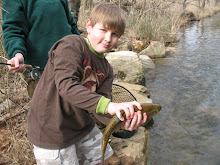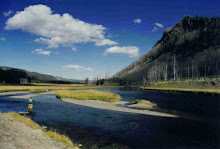 Riseforms......the tell tale ring of a feeding trout on the water's surface. For many anglers its what fly fishing is all about.....casting to a rising fish. But rising fish, though feeding and an easy visible target, can be difficult to catch, particularly if you can't tell what the fish are feeding on. In this short piece, I will give you a few ideas on fishing to rising trout..and what some of the different types of rises are...and what they indicate.....and most importantly, what you may want to consider if you are to be successful fishing to them. In our area anglers are most likely to have these opporunities to cast to risers on our tailwater rivers...but you will see them everywhere on occasion.
Riseforms......the tell tale ring of a feeding trout on the water's surface. For many anglers its what fly fishing is all about.....casting to a rising fish. But rising fish, though feeding and an easy visible target, can be difficult to catch, particularly if you can't tell what the fish are feeding on. In this short piece, I will give you a few ideas on fishing to rising trout..and what some of the different types of rises are...and what they indicate.....and most importantly, what you may want to consider if you are to be successful fishing to them. In our area anglers are most likely to have these opporunities to cast to risers on our tailwater rivers...but you will see them everywhere on occasion.It is important to note that while trout all rise at one time or another all trout don't necessarily act the same from river to river. Also, the size of the rise is not always indicative of the size of the fish. Observation is the key, we need to study the fish, fish behavior, and the foods they eat more than we do assembling a vast array of equipment and flies. Here are a few of the riseforms that are common and that you are likely to see if you fish over rising fish regularly:
1) The Bulge - With this type of riseform the fish is taking subsurface insects, quite possibly midges or mayfly nymphs just under the surface. On area waters this is common with blue winged olives and sulphurs. One way to fish to this rise is with a small nymph or midge pupae just under the surface under a tiny indicator or dry fly (using the nymph or pupae as a droppper), or using a greased leader technique. The latter involves using paste floatant and coating the leader down to within a few inches to 10" of the fly, leaving this last portion untreated. The fly will then drift in the area of the water column that is just under the surface.
2) Boils - similar to a bulge rise, but more violent, and this feeding is also occurring just under the surface. The rise is usually not only violent but erratic as the food item is struggling or is quite animated or active. Usually this rise involves mayfly emergers or caddis emergers. One way to fish this rise is like the above but imparting a twitch or pulsing movement to the fly right as it comes into view of the fish. You can also get above the fish, put yourself at an angle to it, and 'raise' the fly while twitching it as it swings in front of the boiling trout. Another option, and this works well on occasion, is to strip the fly like a streamer, except that you use tiny half to one inch strips, imparting a slight and short pause every 8 or 10 strips....this can be deadly during a hatch.
3) Sips - the sipping rise is classic and if you can see the fish its great fun to watch a trout feed this way...especially if its a large fish. Sips clue you in that a fish is eating small surface insects or slower emergers in the surface film. Small mayfly duns, midges, and mayfly spinners all will cause this type of rise. Sippers are often found in quiet edgewaters, pools, eddies, tailouts, and other margins where the water is slow. Beetles and ants fall into this category as once they fall in they sit very low in the surface film....and they will almost always be sipped. Also, shallow, gentle riffs are a good place to see sippers as well.
4) Head Risers - this rise in one in which the fish lifts its head or part of its head almost vertically out of the water. This type of rise is almost always going to coincide with surface food. So in order to be successful you would fish a surface fly....our CDC emerger flies are murderous on this type of fish......like last week when we nailed a 23" plus brown trout on the South Holston that was head rising. The fish ate a #18 dorothea emerger.... Usually head risers tend to be the larger, more mature fish and they do it so well they seem to make an art of it. Head risers are often eating emerging mayflies that are halfway through the surface film, spinners, terrestrials, and they are often bank feeders as well.
5) Gobblers - this happens a lot out west when the fish have lots of food coming to their feeding station. Have only seen it once before around here, and that is the South Holston tailwater. The food or hatch has to be heavy. I have seen this during some heavy sulphur emergences, and also witnessed it on the Missouri River in Montana during the caddis flights and Silver Creek in Picabo, Idaho during a morning Trico spinner fall. In this type of rise the fish rises and takes a food item once every second for ten seconds or more, then stopping the rising and taking time to swallow all the food it captured. This type of rising is very rare but when you see it it is a sight to behold.....it makes you quiver and shake and your knees will knock together...
6) Porpoising - with a porpoising rise you see the head, back, dorsal, and tail in a slow parade as the fish takes food....this rise sometimes exaggerates the fish's true size. Porpoising indicates the presence of smaller, emerging flies, and to catch fish doing this you will want an array of mayfly nymphs and emergers, midge pupae and emergers, and all of them should be in the film patterns or ones that sit low on the water.
7) Tailing - very uncommon unless the water has lots of weedbeds or vegetation...fish feeding this way are likely rooting out mayfly nymphs, cressbugs, scuds, and whatever else they can find.
8) Splashy Rises - often belies a small or juvenile fish, they seem to get really excited about feeding.....and often seeing a really splashy rise is really nothing more than small fish. This happens alot during a caddisfly emergence, and with some swiftly emerging mayflies too. Moving the fly or twitching it, stripping it, raising it in front of a fish doing this will work well.
Hopefully this will give you a little insight into the riseforms of trout. They are amazing creatures, and coming up with the right fly and/or technique for the rising fish of the moment is about as good as it gets...especially if a fish winds up in the net.




























No comments:
Post a Comment